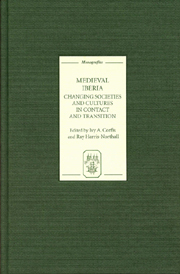Book contents
- Frontmatter
- Contents
- Acknowledgements
- Introduction
- Part 1 SOCIAL AND CULTURAL MINORITIES IN CHANGING SOCIETIES
- Part 2 CONTACT AND CONFLICT: PERSPECTIVES ON HISTORY AND CULTURE
- Visigoths and Asturians Reinterpreted: The Spanish Grand Narrative Restored?
- Against the Arabs: Propaganda and Paradox in Medieval Castile
- Conquest and Conversion in the Hispanic Chivalric Romance: The Case of Reinaldos de Montalván
- Part 3 TRANSMISSION OF LEARNING AND TEXTS IN CHANGING CULTURES
- Part 4 LINGUISTIC CONTACT AND CHANGE
- Index
Conquest and Conversion in the Hispanic Chivalric Romance: The Case of Reinaldos de Montalván
from Part 2 - CONTACT AND CONFLICT: PERSPECTIVES ON HISTORY AND CULTURE
Published online by Cambridge University Press: 12 September 2012
- Frontmatter
- Contents
- Acknowledgements
- Introduction
- Part 1 SOCIAL AND CULTURAL MINORITIES IN CHANGING SOCIETIES
- Part 2 CONTACT AND CONFLICT: PERSPECTIVES ON HISTORY AND CULTURE
- Visigoths and Asturians Reinterpreted: The Spanish Grand Narrative Restored?
- Against the Arabs: Propaganda and Paradox in Medieval Castile
- Conquest and Conversion in the Hispanic Chivalric Romance: The Case of Reinaldos de Montalván
- Part 3 TRANSMISSION OF LEARNING AND TEXTS IN CHANGING CULTURES
- Part 4 LINGUISTIC CONTACT AND CHANGE
- Index
Summary
In one of the few articles dedicated to the topic of conversion in the Castilian chivalric romance, Whitenack surveys Hispanic chivalric texts published between the years 1490 and 1524. She finds that enforcing baptism on the principal warriors and the army en masse is a pattern found in a wide range of medieval (pre-1490) works (15). She also states that fifteenth- and sixteenthcentury Castilian translations of chivalric fiction, such as Historia de los nobles cavalleros Oliveros de Castilla y Artús de Algarbe, differ little from the medieval romances, where conversion is ‘narrated perfunctorily and with little attempt to justify or explain [it]’ (17). According to Whitenack, in the translations and medieval romances, methods of conversion were based on power and intimidation and included:
defeat by a Christian army, miracles or visions, promises of future benefits (military, martial or material), or capture by an individual Christian; sometimes one finds in addition a brief reference to instruction, persuasion or preaching […]. Conversion is treated as merely a symbol of a change in political allegiance, so common and so natural an event that no lengthy discussion or rationalization was necessary. (20)
However, one translation not taken into consideration, Reinaldos de Montalván, follows many of the patterns the critic notes for indigenous Peninsular romances and, if considered in Whitenack's study, might have altered her conclusions somewhat, for while it clearly demonstrates many of the characteristics that she describes for medieval works and translations, it offers other, more detailed reasons for and methods of conversion.
- Type
- Chapter
- Information
- Medieval IberiaChanging Societies and Cultures in Contact and Transition, pp. 70 - 84Publisher: Boydell & BrewerPrint publication year: 2007



